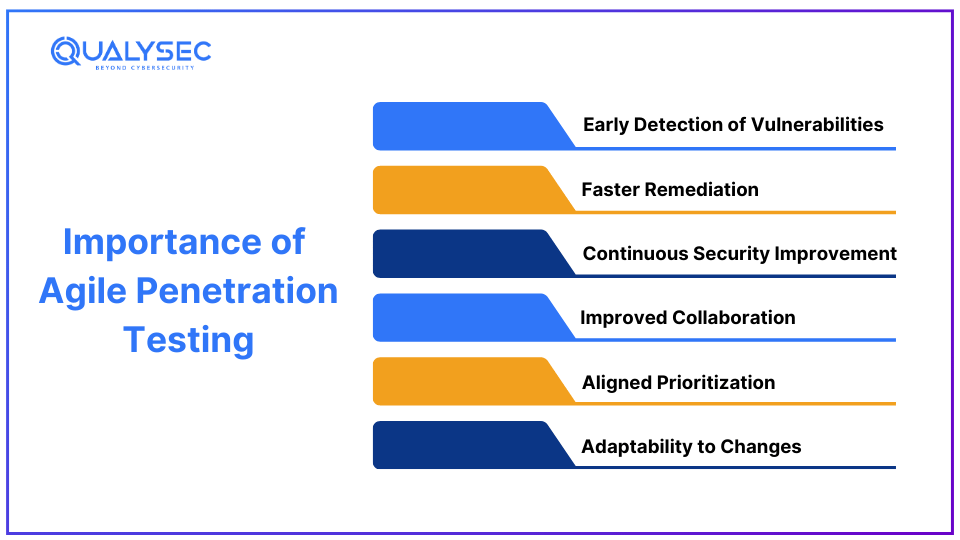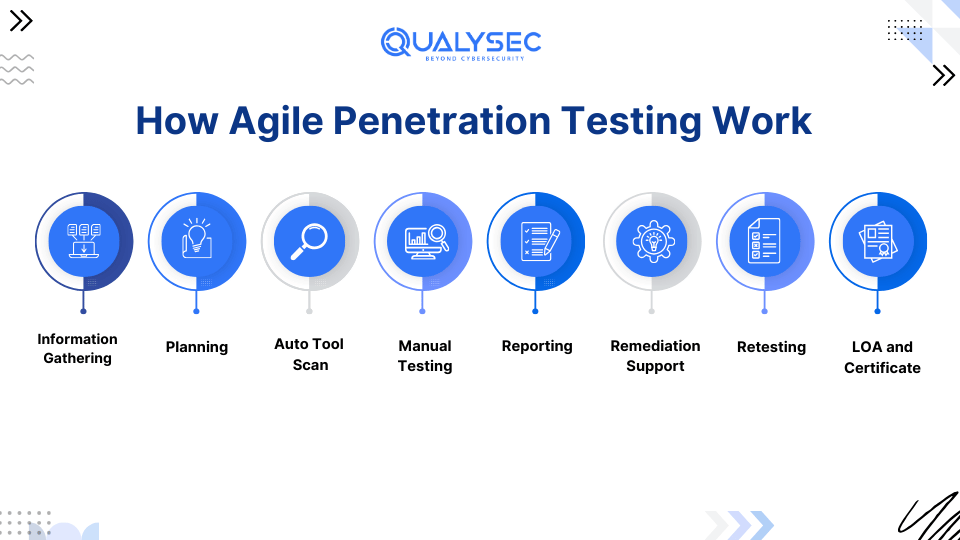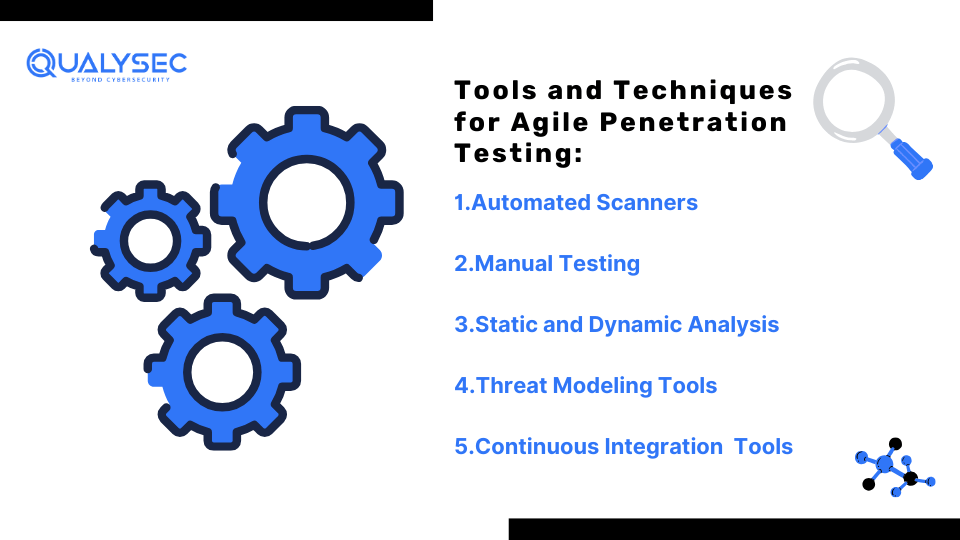Due to the increase in the rate of development and the adoption of methodologies such as Agile, security has become an important aspect. Agile Pentesting is one of the techniques that support the implementation of penetration testing in Agile frameworks. Moreover, penetration testing in the traditional approach would be run at the end of a development cycle. In Agile penetration testing, teams perform test in every sprint or iteration. Therefore, a continued security evaluation helps identify threats for their remediation in a timely manner, thus promoting the secure development life cycle.
For example, let us consider a development team working on a new e-commerce platform. During each sprint, the team introduce more features and enhance existing ones. Hence, in Agile Pentesting, security experts evaluate the changes in real time to detect and neutralize new threats as they emerge.
However, the blog will provide a detailed overview of agile penetration testing, its importance, methodology, tools and best practices.
What is Agile Penetration Testing?
Agile penetration testing is an ongoing security testing methodology that can help organizations accelerate the delivery of secure software to their clients. Moreover, compared with traditional pen testing, which tends to slow product teams, agile pentesting integrated into the SDLC can run in line with your release schedules.
Furthermore, this prevents your organization from having to spend time and money fixing problems that may have been easy to address at an earlier stage. Agile pen testing enables identifying and addressing possible threats in an application with existing timelines and schedules of product releases.
Why Agile Pen testing is Important?

Agile Penetration Testing is important for organizations seeking to improve their software security posture within an Agile development environment:
1. Early Detection of Vulnerabilities
When security testing is performed as part of the Agile process, weaknesses can be found and fixed before they become entrenched in the SDLC. This, therefore, makes it easy to eliminate occasional serious vulnerabilities that may be overlooked until subsequent development phases.
2. Faster Remediation
The increased number of testing cycles makes it possible to detect security threats faster and address them accordingly. This limits the exposure time and offers potential attackers limited time to exploit the discovered weaknesses.
3. Continuous Security Improvement
Agile Penetration Testing is also designed to enhance the spirit of teamwork for improvement by offering analysis and feedback to development teams at appropriate intervals. This assists organizations in identifying weaknesses in security practices and continuously improving their teams’ performance.
Integrating security testing services into Agile workflows helps teams address vulnerabilities more effectively and maintain a strong security posture throughout development.
4. Improved Collaboration
Properly integrating the security principle in the Agile process improves the collaboration between development teams, security teams and other stakeholders. Thus, established cooperation helps address security issues and enhance the communication of these concerns.
5. Aligned Prioritization
By introducing the principles of Agile Pen testing, vulnerabilities can be ranked and prioritized depending on their likelihood and consequences. Furthermore, it helps in making sure that the development teams are targeting and solving the most important issues in terms of security.
6· Adaptability to Changes
One of the principles of Agile methodologies is flexibility in adopting changes and updates in software. Agile Penetration Testing does the same thing by modifying its testing activities according to the changes in the code base, architecture and functionality of the application.
How Agile Penetration Testing Works?

1. Information Gathering:
Gather information on systems layout, network configuration, user profiles and information flows. Thus, this drives the scope and key techniques in an agile audit plan.
2. Planning:
Set specific, measurable objectives that align with the scope of work within specific agile sprints. Create an audit plan flexibly for the scope, methodologies, benchmarks, tools, and testing environments.
3. Auto Tool Scan:
Automate tools scan for vulnerabilities in a protective environment. This helps identify potential problems that would hinder the performance of the working applications.
4. Manual Testing:
Perform manual testing for the overlooked vulnerabilities, such as input validation and encryption testing, thus covering all necessary tests.
5. Reporting:
The next step is to record the observed facts and conclusions in detail and with maximum clarity. A senior consultant improves the pentesting report and adds the best practices and recommendations for security enhancement.
Do you want to know what an agile pen testing report looks like? Click below to get your copy of the sample report!
Latest Penetration Testing Report

6. Remediation Support:
Provide support for development teams in addressing such vulnerabilities as outlined during the assessment. This cooperation provides timely decision-making, improves further contingencies, and strengthens the safety of the operations.
7. Retesting:
To make sure the issue is fixed, a company performs re-test. Submit written narratives of observations and developments, including analysis of evidence demonstrating that the weaknesses have been mitigated.
8. LOA and Certificate:
Provide a Letter of Attestation and certificate asserting the stated application’s security and the audit process’s efficiency.
Tools and Techniques for Agile Penetration Testing

Agile Pentesting utilizes both automated and manual methods to expose vulnerabilities in the target network or system. Some commonly used tools and techniques include:
1. Automated Scanners:
Some tools include Burp suite, ZAP from OWASP, Nessus, etc. They help scan the applications to check if they are vulnerable to any known vulnerabilities.
2. Manual Testing:
Security testers use manual penetration testing process to detect to detect more sophisticated vulnerabilities that the automated security testing tools may not.
3. Static and Dynamic Analysis:
Static analysis examines the application’s source code to look for security flaws, while dynamic analysis is performed when the application sources are in run-time mode.
4. Threat Modeling Tools:
Such tools as Microsoft’s Threat Modeling Tool help identify potential threats and evaluate the risks that the threats pose.
5. Continuous Integration (CI) Tools:
Security testing can be done at the integration level and executed each time a new code is checked.
Best Practices for Agile Pen Testing
To ensure the effectiveness of Agile Penetration Testing, organizations should follow these best practices:
1. Early and Continuous Testing:
Initiate security testing at the early stages of development and progress throughout the entire program.
2. Collaboration and Communication:
Promote cooperation between security testers, developers, and other people so that all understand security objectives.
3. Prioritization of Vulnerabilities:
Organize priorities, starting with the most severe and intense issues and address them immediately, incorporating vulnerability assessment to tackle other problems effectively.
4. Regular Updates and Patching:
Make sure you frequently update your systems and applications with new security patches and updates, if any.
Looking for more details about agile penetration testing? Here, Speak to our Experts for Free!
Talk to our Cybersecurity Expert to discuss your specific needs and how we can help your business.
Conclusion
It is, therefore, important for organizations that have embraced Agile methodologies to embrace Agile Penetration Testing. Conducting security assessments for each sprint ensures that risks are detected and mitigated early, thereby preventing security issues. This approach not only enhances security but also boosts employee awareness and participation. Moreover, Agile Pentesting aligns with the ever-evolving world of cybersecurity, offering a flexible and efficient approach to application security.
FAQs
1. What is agile-based testing?
A. Agile-based testing is a testing practice derived from the concepts of agile methodologies. It, therefore, entails evaluation, feedback, integration of multi-disciplinary teams and flexibility in the change processes.
2. What is penetration testing in agile methodology?
A. “Agile penetration testing” is testing the system’s security in an Agile environment, where penetration testing is conducted continuously and frequently due to Agile’s iterative and incremental approach.
3. What are the key benefits of Agile Penetration Testing?
A. The key benefits of Agile penetration testing are:
- Detection of vulnerabilities
- Continuous improvement
- Enhance collaboration between security experts and the development team
4. How is Agile Penetration Testing implemented?
A. Agile penetration testing can be perform by incorporating security evaluations into every sprint. It includes identifying the scope and objectives of penetration testing, conducting the penetration testing exercises, analyzing and reporting the results, managing vulnerabilities detected, and monitoring ongoing.








































































































































































































































































































































0 Comments